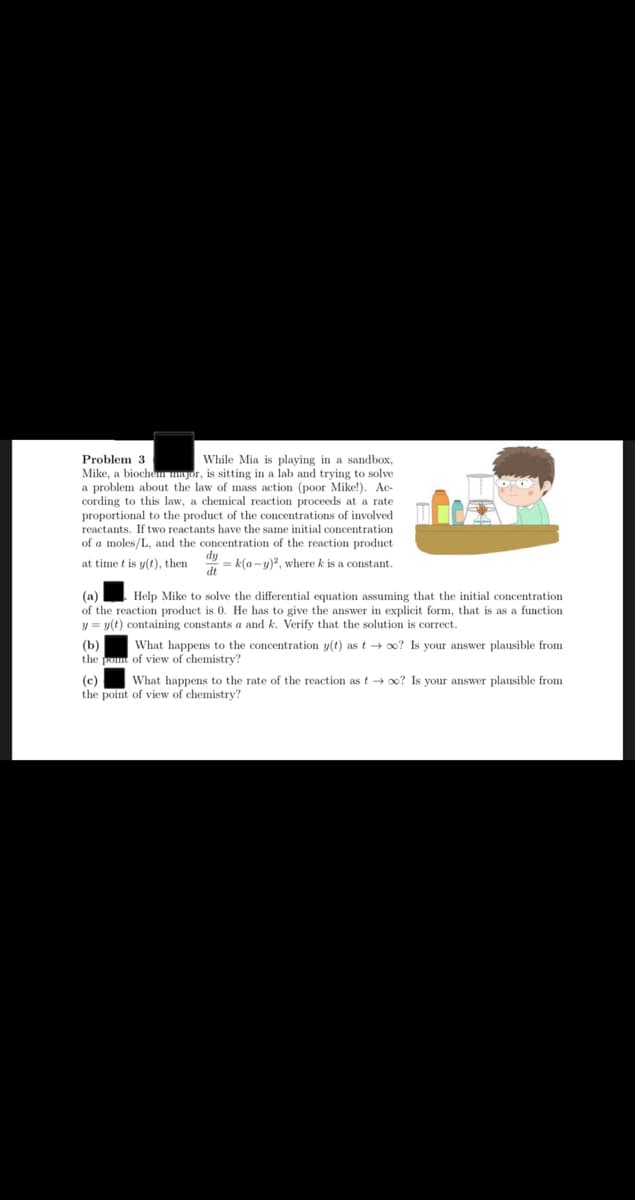While Mia is playing in a sandbox, Mike, a biochem unyor, is sitting in a lab and trying to solve a problem about the law of mass action (poor Mike!). Ac- cording to this law, a chemical reaction proceeds at a rate proportional to the product of the concentrations of involved reactants. If two reactants have the same initial concentration of a moles/L, and the concentration of the reaction product = k(a-y)*, where k is a constant. Problem 3 dy at time t is y(t), the dt (a) of the reaction product is 0. He has to give the answer in explicit form, that is as a function y = y(t) containing constants a and k. Verify that the solution is correct. (b) the pont of view of chemistry? Help Mike to solve the differential equation assuming that the initial concentration What happens to the concentration y(t) as t → oo? Is your answer plausible from (c) the point of view of chemistry? What happens to the rate of the reaction as t oo? your answer plausible from
While Mia is playing in a sandbox, Mike, a biochem unyor, is sitting in a lab and trying to solve a problem about the law of mass action (poor Mike!). Ac- cording to this law, a chemical reaction proceeds at a rate proportional to the product of the concentrations of involved reactants. If two reactants have the same initial concentration of a moles/L, and the concentration of the reaction product = k(a-y)*, where k is a constant. Problem 3 dy at time t is y(t), the dt (a) of the reaction product is 0. He has to give the answer in explicit form, that is as a function y = y(t) containing constants a and k. Verify that the solution is correct. (b) the pont of view of chemistry? Help Mike to solve the differential equation assuming that the initial concentration What happens to the concentration y(t) as t → oo? Is your answer plausible from (c) the point of view of chemistry? What happens to the rate of the reaction as t oo? your answer plausible from
Algebra and Trigonometry (MindTap Course List)
4th Edition
ISBN:9781305071742
Author:James Stewart, Lothar Redlin, Saleem Watson
Publisher:James Stewart, Lothar Redlin, Saleem Watson
Chapter10: Systems Of Equations And Inequalities
Section10.FOM: Focus On Modeling: Linear Programming
Problem 14P
Related questions
Question
100%
Please solve ASAP with full work shown!

Transcribed Image Text:Problem 3
Mike, a biochem major, is sitting in a lab and trying to solve
a problem about the law of mass action (poor Mike!). Ac-
cording to this law, a chemical reaction proceeds at a rate
proportional to the product of the concentrations of involved
reactants. If two reactants have the same initial concentration
While Mia is playing in a sandbox,
of a moles/L, and the concentration of the reaction product
dy
= k(a-y)?, where k is a constant.
dt
at time t is y(t), then
(a)
of the reaction product is 0. He has to give the answer in explicit form, that is as a function
y = y(t) containing constants a and k. Verify that the solution is correct.
Help Mike to solve the differential equation assuming that the initial concentration
What happens to the concentration y(t) as t → ? Is your answer plausible from
(b)
the pomt of view of chemistry?
What happens to the rate of the reaction as t + oo? Is your answer plausible from
(c)
the point of view of chemistry?
Expert Solution
This question has been solved!
Explore an expertly crafted, step-by-step solution for a thorough understanding of key concepts.
Step by step
Solved in 3 steps with 3 images

Knowledge Booster
Learn more about
Need a deep-dive on the concept behind this application? Look no further. Learn more about this topic, algebra and related others by exploring similar questions and additional content below.Recommended textbooks for you

Algebra and Trigonometry (MindTap Course List)
Algebra
ISBN:
9781305071742
Author:
James Stewart, Lothar Redlin, Saleem Watson
Publisher:
Cengage Learning

Trigonometry (MindTap Course List)
Trigonometry
ISBN:
9781337278461
Author:
Ron Larson
Publisher:
Cengage Learning

Algebra and Trigonometry (MindTap Course List)
Algebra
ISBN:
9781305071742
Author:
James Stewart, Lothar Redlin, Saleem Watson
Publisher:
Cengage Learning

Trigonometry (MindTap Course List)
Trigonometry
ISBN:
9781337278461
Author:
Ron Larson
Publisher:
Cengage Learning